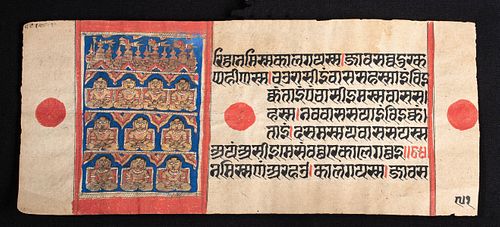15th C Jain Gilded Manuscript Page w/ Tirthankaras
Lot 54a
About Seller
Artemis Fine Arts
686 S Taylor Ave, Ste 106
Louisville, CO 80027
United States
Selling antiquities, ancient and ethnographic art online since 1993, Artemis Gallery specializes in Classical Antiquities (Egyptian, Greek, Roman, Near Eastern), Asian, Pre-Columbian, African / Tribal / Oceanographic art. Our extensive inventory includes pottery, stone, metal, wood, glass and textil...Read more
Categories
Estimate:
$400 - $600
Absentee vs Live bid
Two ways to bid:
- Leave a max absentee bid and the platform will bid on your behalf up to your maximum bid during the live auction.
- Bid live during the auction and your bids will be submitted real-time to the auctioneer.
Bid Increments
| Price | Bid Increment |
|---|---|
| $0 | $25 |
| $300 | $50 |
| $1,000 | $100 |
| $2,000 | $250 |
| $5,000 | $500 |
| $10,000 | $1,000 |
| $20,000 | $2,500 |
| $50,000 | $5,000 |
| $100,000 | $10,000 |
| $200,000 | $20,000 |
About Auction
By Artemis Fine Arts
Jan 21, 2021
Set Reminder
2021-01-21 10:00:00
2021-01-21 10:00:00
America/New_York
Bidsquare
Bidsquare : Ancient / Ethnographic From Around The World
https://www.bidsquare.com/auctions/artemis-gallery/ancient-ethnographic-from-around-the-world-6316
Ancient art from Egypt, Greece, Italy and the Near East, as well as Asian, Pre-Columbian, Native American, African / Tribal / Oceanic, Spanish Colonial, Russian Icons, Fine art, much more! All categories, all price ranges... all legally acquired and guaranteed to be as described or your money back. Artemis Fine Arts info@artemisgallery.com
Ancient art from Egypt, Greece, Italy and the Near East, as well as Asian, Pre-Columbian, Native American, African / Tribal / Oceanic, Spanish Colonial, Russian Icons, Fine art, much more! All categories, all price ranges... all legally acquired and guaranteed to be as described or your money back. Artemis Fine Arts info@artemisgallery.com
- Lot Description
South Asia, western India, Gujerat region, ca. 15th century CE. A stunning Jain manuscript page with ten Tirthankaras bordering a Jain religious text, perhaps from a Kalpasutra, on fine beige-hued paper and embellished with a lustrous 15 karat gold gilding, black ink, and pigments in hues of crimson and cobalt. A Tirthankara, literally meaning "ford-maker" in Sanskrit, is a spiritual teacher, savior, founder of the tirtha, and conqueror of the samsara (cycle of death and rebirth) who made a path for others to follow. The page presents on one side with seven lines of Jain text beside a decorative rectangle of black ink drawings skillfully gilded and painted with blue and red pigments. This beautiful image features a stylized skyline-like design above ten Tirthankaras sitting cross-legged and organized in three rows. Three equally-spaced red circles additionally adorn the page. Size: 9.875" W x 4.25" H (25.1 cm x 10.8 cm); gilding quality: 62.5% (equiavalent to 15 K)
Alternatively, the other side of this ancient document presents with seven lines of Hindi script of Jain text in hues of black and vibrant red fit between two vertical red striations with a red circle at the center.
According to an essay entitled "Jain Manuscript Painting" by John Guy (Department of Asian Art, Metropolitan Museum of Art), "One of the identifying features of fifteenth-century Jain painting is the increasingly lavish use of applied gold. A unique illustrated Kalpasutra manuscript from Jaunpur, Uttar Pradesh, dated ca. 1465, displays a restrained and highly effective use of gold and an intense blue sourced from lapis lazuli (1992.359). The use of both these colors had resulted from an awareness of Persian painting, which had become accessible through sultanate connections. The manuscript to which this folio belongs also introduces clear evidence that Jain patronage had extended by this time beyond Gujarat and Rajasthan into Central and Northern India. While retaining the broad conventions of the western Indian style, it displays a bold approach to color and rich ornamentation that connects the archaic western style with the emerging North Indian schools, which gained their fullest expression in the studio workshops of Delhi and surrounding regions. This legacy is seen in the court style of Malwa and other schools of the late fifteenth and sixteenth centuries."
Provenance: ex-Estate of Eldert Bontekoe, Pegasi Numismatics, Ann Arbor, Michigan, USA, acquired before 2000
All items legal to buy/sell under U.S. Statute covering cultural patrimony Code 2600, CHAPTER 14, and are guaranteed to be as described or your money back.
A Certificate of Authenticity will accompany all winning bids.
We ship worldwide and handle all shipping in-house for your convenience.
#158256Single page from a larger manuscript. Miniscule tearing to some small areas of peripheries. Light staining commensurate with age. Otherwise, excellent with remarkable remaining pigment.Condition
- Shipping Info
-
All shipping is handled in-house for your convenience. Your invoice from Artemis Gallery will include shipping calculation instructions. If in doubt, please inquire BEFORE bidding for estimated shipping costs for individual items.
-
- Buyer's Premium



 EUR
EUR CAD
CAD AUD
AUD GBP
GBP MXN
MXN HKD
HKD CNY
CNY MYR
MYR SEK
SEK SGD
SGD CHF
CHF THB
THB














